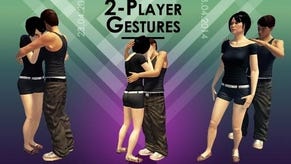PlayStation Home: What's new?
"You'll be pleasantly surprised."
The Game Developers Conference is perhaps where PlayStation Home's heart is. After all it was there, in 2007, that Phil Harrison unveiled Sony's vision of a networked virtual world for PlayStation 3.
As announced at last month's GDC, Home has since been downloaded 19 million times and has seen many evolutions. And now more changes are occurring with the launch of new tools designed to increase the options developers have when it comes to creating games for Home.
But what does this mean for the average PS3 owner? Will the changes be enough to make those who have left Home want to return? Eurogamer sat down with Jack Buser, director of Home for Sony Computer Entertainment America, to find out.
These new tools will give our game development community the tools they need to build better games than you've ever seen before in Home. The new client will allow games to have better graphics, more robust physics and online, real-time multiplayer capability.
This will allow us to build game types like online multiplayer first-person shooters, racing games... All kinds of game types that maybe you haven't ever seen before in PlayStation Home.
One of the great things about PlayStation Home is that it's leveraging the power of the PlayStation 3 hardware to provide these 3D immersive experiences that normally you wouldn't be used to seeing in social games.
Also, the game types that we see in PlayStation Home cater much more towards the core PS3 demographic. So you're going to see things like shooters on the platform which, traditionally, social games don't necessarily support.
In terms of graphical capability per se, I wouldn't really draw an overarching comparison. I'd leave it up to the consumer to decide, when they're playing these game, how they feel about the graphical quality. Personally, I think some of them are absolutely beautiful.
Well, there are a few big differentiators to playing games inside PlayStation Home rather than standalone retail games or our downloadable games. The first of these is that you're playing these games as part of a continuous world.
So as you're wandering around this world, you might just find a game and find yourself as part of that game without really knowing you've joined a game. Or you might just see a group of people huddled round a game, wonder what it is and wander over to check it out, in a very seamless way.
One of the most fun things in PlayStation Home is wandering around the world and finding all the great games there are to play, that maybe you wouldn't know about otherwise.
Secondly, I'd imagine a big differentiator is the business model. Many of these games, like Home itself, are free to play.
At conferences like GDC, we toss around the word freemium. [Home racing game] Sodium 2 you can play absolutely for free - boot up Home, we don't charge anything, go over to Sodium 2 and start racing. That is very differentiated from traditional retail or downloadable games where you'd have to pay.
So if you want to play with your friends on Sodium 2, you can just tell them to come on in , it's free and you don't have to buy anything.

The freemium business model is a new business model in games that's gathering a lot of traction on social game platforms in general.
The core philosophy is that these games are free to play and you don't have to buy anything, but if you want that extra edge you can buy a special weapon or booster or some sort of special something, at a very low price point, generally via microtransactions, which gives you an edge in the game.
You don't have to but you can if you want to, and that's the core of the experience. You'll have some subset of the overall audience that will want that edge.









